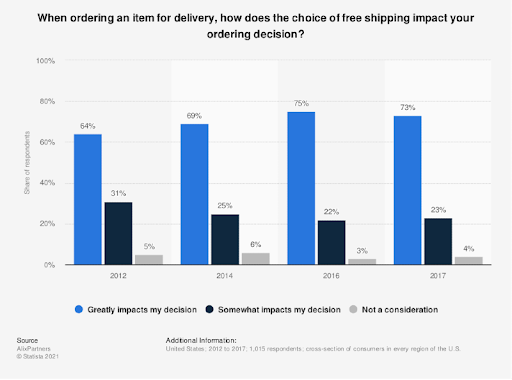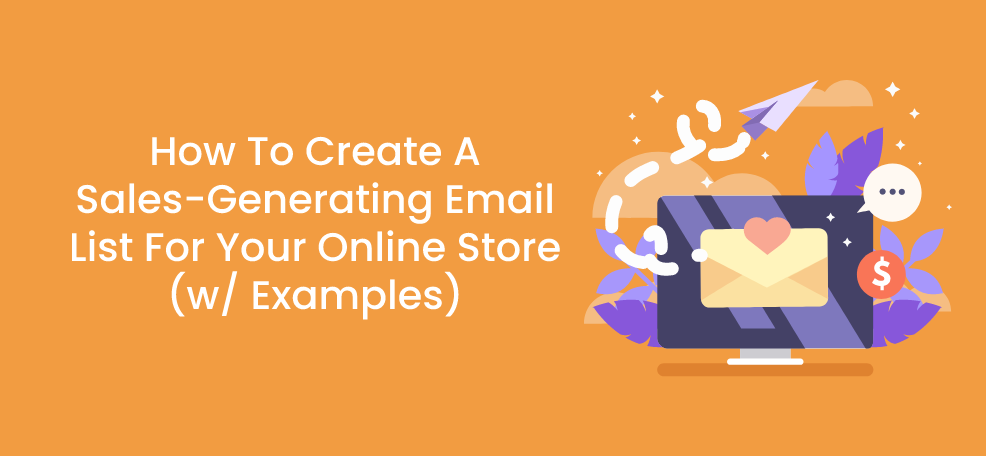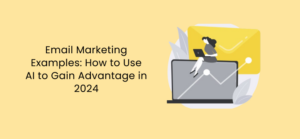How would you react if you knew there was a marketing tool at your fingertips that has the potential to return $40 for every $1 spent? Sounds too good to be true, doesn’t it? Well, it’s genuine, and what’s more, it’s one you’re already using; email.

Your email mailing list is a potential goldmine. Unlike social media and pay-per-click advertising, it’s also one that you have total control over. You don’t need to worry about algorithms or search engines to get your message across. It’s an instrumental part of any customer engagement strategy.
But how do you build a list of subscribers in the first place? In this article, we’ll show you. Here are several tips on what to do to take advantage of all email has to offer.
1. Recognize and define your target market
First, you have to identify who exactly your business is geared towards. You want to have a clear idea of who you want subscribing to your emails before you try to reach them.
A business that tries to appeal to everyone will waste vast amounts of time and resources. They make a nuisance of themselves in the process. For instance, a company specializing in selling skateboards wouldn’t try to sign up local clergy members.
You may already have a clear idea of who you want to attract. If not, you’ll need to do some market research.
2. Conduct market research and find your current audience
To do this, you’ll need to analyze the people who already use your business. It may sound complicated, but thanks to the Internet, it’s never been easier. There are several factors you’ll need to consider:
- Your customer age range.
- Their location.
- Their income.
- Demographics.
- What devices they use.
All of this data can help you understand your customer base better and respond effectively.
Lots of helpful information is generated when shopping online that you can use to influence your strategy. For instance, if your sales are all locally generated, you’ll know to target the surrounding community. On the other hand, if they’re coming from abroad, you could consider adapting your website, so it’s available in different languages and makes it easier for overseas customers to use.
There’s a wealth of analytical tools available online to help with this, such as Google Analytics. The more you specialize in line with their needs, the more likely they’ll sign up to your mailing list.
3. Examine your product for defects
It might sound obvious, but it’s worth repeating: always check to see how you can improve your product. What problems does it solve? What problems does it have? Increasing the former and reducing the latter should always be at the back of your mind.
After all, your product is why the customer is there in the first place. If it’s not up to scratch, it doesn’t matter how good your email strategy is.
Suppose the previously-mentioned skateboard company were lucky and found a vicar who happened to be an extreme sports fan; it would all be for nothing if the wheels fell off after a month. Yes, they were able to make a sale initially, but they had to refund a very bruised and frustrated customer later and he likely clicked ‘unsubscribe’ as soon as he got home.
4. Conduct a competitor analysis
Finding out who your competitors are targeting and how successful they are is another essential part. There are several ways to conduct a competitor analysis.
For instance, if your competitors use blogs, it’s possible to use online tools to check out which of their posts are performing well. You can use programs like Content Studio to analyze how articles perform on social media.
It’s also worth taking the time to examine their web pages, especially if they’ve created segmented landing pages for their audience. If they have a particularly user-friendly and efficient set-up, there’s no reason you can’t try to replicate it for your site.
5. Create a buyer persona
Once you’ve gathered as much buyer data as possible, you may find it helpful to create a buyer persona.
As a child, you may have had an imaginary friend. Buyer personas are the adult equivalent for marketers. This semi-fictional character isn’t there to alarm your parents and teachers; it’s to help you comprehend who your ideal customer is; the more detailed and specific, the better.
A clearly defined buyer persona will help you understand who to target and optimize your campaign accordingly. Arguably, their most significant benefit is helping to determine who you shouldn’t be targeting. There is no sense in repeatedly chasing leads from people who are not interested.
So from the information you’ve gathered, what picture emerges? And how do you tailor your approach especially for them?
6. Create distinct landing pages for each of your products
An excellent way to help generate sales is to make the customer experience as personal as possible. One way to do this is via specialized landing pages.
Landing pages help attract a specific audience and are thus an excellent way to encourage people to sign up for your mailing list. Consider this one for example;

This company is running a promotion on practice exams for aspiring app builders. They’ve created this landing page to publicize it, and it’s got that same audience in mind. They will have researched the SEO and chosen the language carefully to attract clicks.
Anyone from that demographic who finds this page will feel like their needs is being directly addressed, and consequently, they’ll be more amenable to signing up to an email list.
7. Create an engaging lead magnet
One thing to bear in mind is that building an email list requires a degree of trust. Your contact information is personal data, and it’s only natural that some people will feel hesitant to hand it over. They’re wary of scammers and spam, so it’s understandable they’ll be cautious.
One way to build that trust is to offer them something in return. This approach is known as a lead magnet. And the freebie could be anything; a discount, a consultation, a white paper, it’s up to you.
Pop-ups are an excellent way to deliver lead magnets, providing you don’t break the golden rule: they mustn’t be annoying. If a visitor to your site closes a pop-up, it shouldn’t reappear ten seconds later, and there shouldn’t be one on every page. Otherwise, they become intrusive and will only motivate people to leave your site and not return.
Used sparingly and efficiently though they can be effective. Take a look at this one:

It’s eye-catching, the offer of a discount is right at the center and the ‘X’ to close it is visible. Nobody likes having to scour every inch of the screen trying to figure out how to close an unwanted advert, so anyone who isn’t interested in this deal can shut it down quickly. This pop-up can attract extra custom but isn’t so intrusive it will put people off.
8. Freebies and discounts
Let’s imagine that you need to invest in a desktop computer. After doing some research online, you find a top-of-the-range model on sale at an electronics store, and it’s perfect for your needs. Best of all, there’s an introductory offer; 15% off for new customers. All you need to do in return is provide your email address.
It’s hard to turn down, isn’t it? A few marketing emails in exchange for a reduced price is a terrific deal. You take the plunge and make a considerable saving. Then a few weeks later, you’re clearing out your inbox when you notice another email from that company advertising a sale on laptops. Your daughter is leaving for college soon; perhaps she could do with a new one?
Maybe you only ever intended to make that first purchase and take advantage of the discount. It’s understandable; everybody loves a bargain. But the computer you bought is fast and reliable and great value for money. The company earned your trust, and you’re on the way to becoming a repeat customer.
You wouldn’t have heard about the laptop sale without the email, and you wouldn’t have seen the email if that initial discount hadn’t nudged you to sign up. It’s a common marketing strategy, but it works.
9. Free shipping
Free shipping is another popular type of lead magnet. The cost of transporting goods can be off-putting, and many sales have been lost because of it. For example, a funky and eye-catching T-shirt may look very appealing when it costs $30, but once another $15 is added for delivery? Not so much. Maybe it’d be worth looking elsewhere?
That’s why offers of free shipping are so attractive. Customers want to see the total cost of an item upfront and do not like additional fees. You cannot overlook the extent to which it influences purchasing decisions:

If you do consider offering free delivery, there are things you have to bear in mind. Are you providing it as a one-off for first-time customers or as a long-term plan? You’ve also got to maintain standards; free delivery is no excuse for lost or damaged items. Generating lots of new sales is no good if the majority of those customers never return.
10. Widgets
Widgets are the unsung heroes of eCommerce. They’re a valuable tool for obtaining data, and most of the time, people don’t even notice they’re there. That little chat button in the corner of a website with “Help” written on it? That’s a Widget.
They’re also relatively easy to set up. Most have copy-and-paste code blocks that you can embed into your website without drastic changes to the framework.
The goals of web widgets are:
- To encourage customers to use self-service resources
- Allow visitors to message your team
- Enable them to start a live chat
Used well, they can make a big difference and they are a handy tool considering how often they’re overlooked.
Conclusion
Email is a potent marketing tool, and it would be wise to take advantage of it. Once you’ve established a database of subscribers, though, use it wisely. Be sure not to send a dozen emails a day; overwhelming your customer’s inbox will turn them against you.
Follow these suggestions, and you’ll be well on your way to building a sizeable email subscription list. Use email (including your list, of course) well, and it will yield incredible returns.
Author’s Bio

Martin Gessner is the Founder of Focus on Force. He has spent over 10 years working in various Salesforce roles, including business analyst, project manager, consultant, and solutions architect. Along the way, he has earned twelve certifications, published “The Salesforce Career Playbook”, and helped Salesforce professionals learn more about Salesforce, develop their careers and prepare for certifications.




